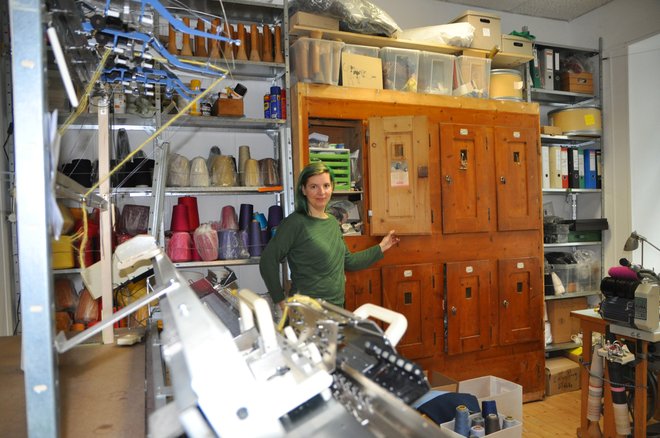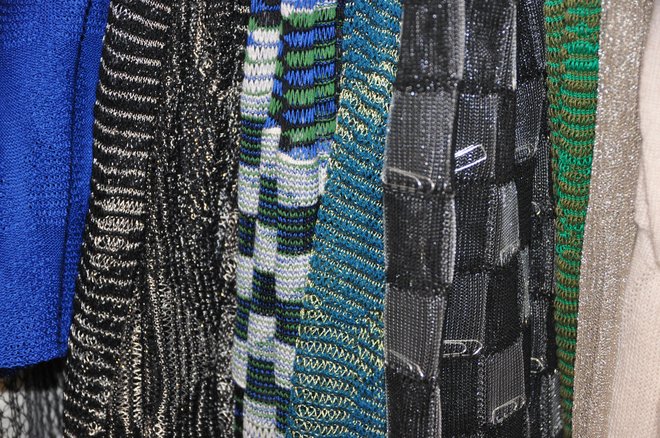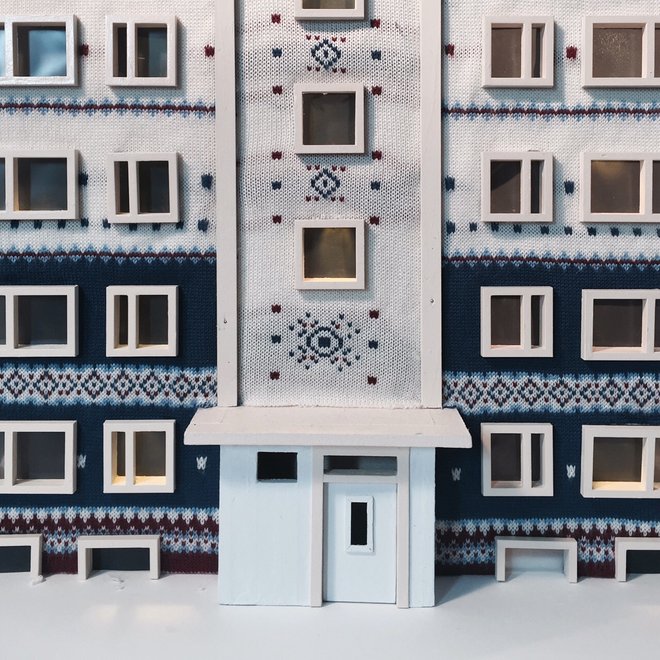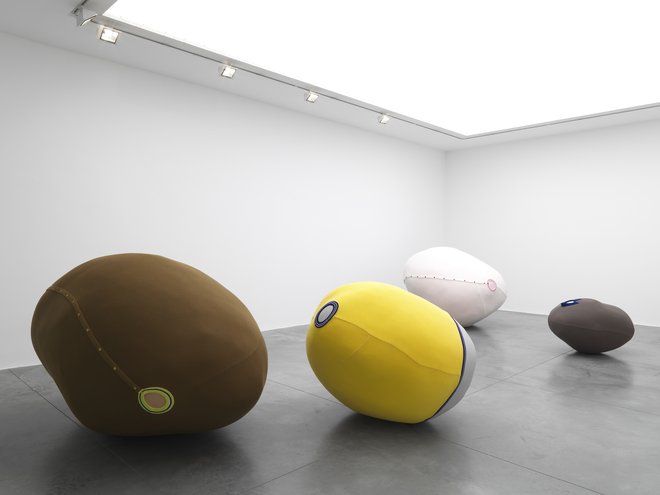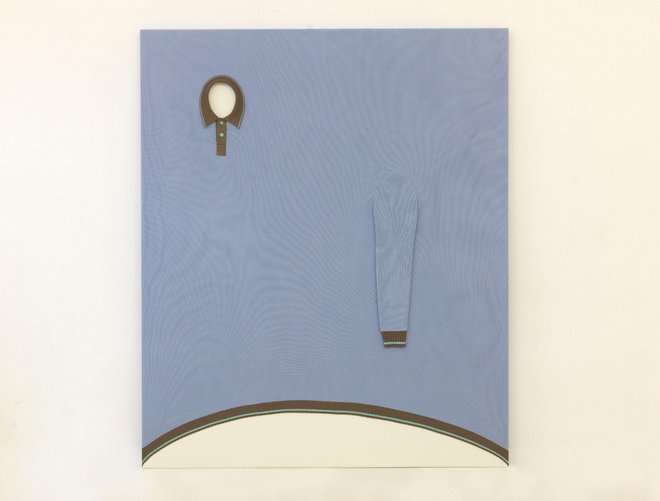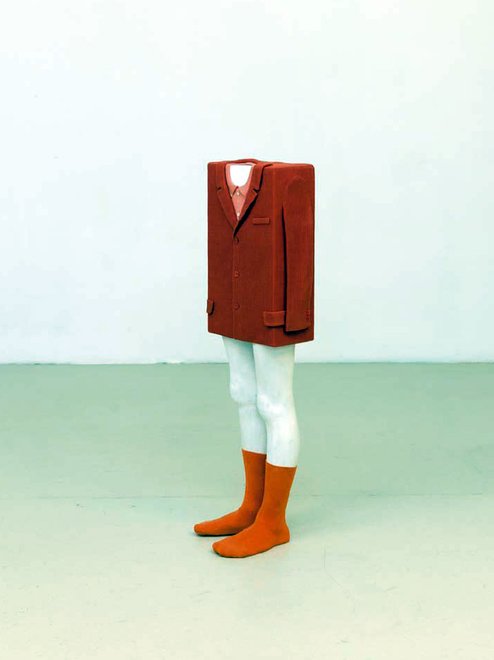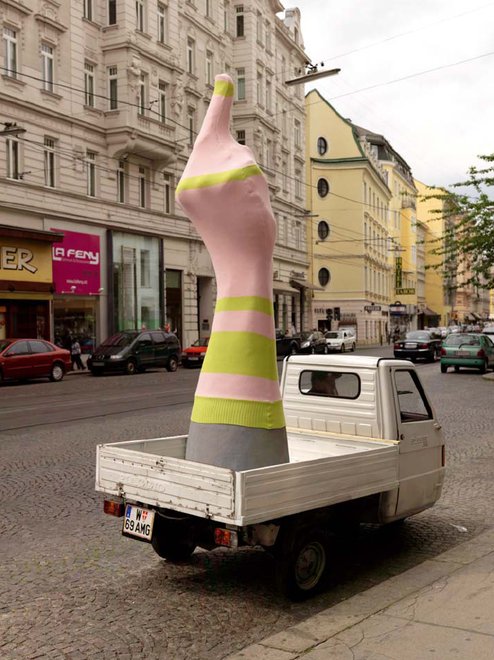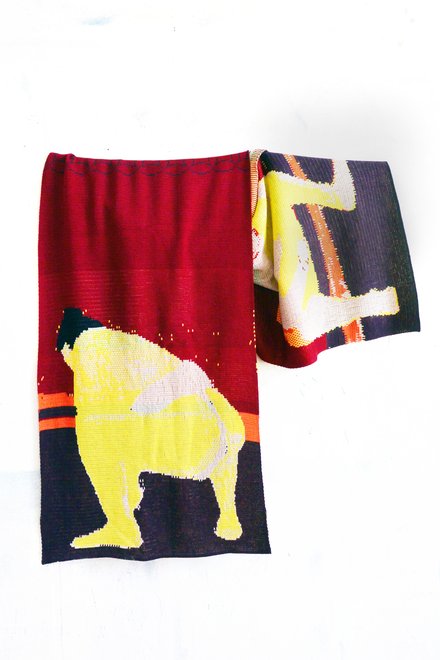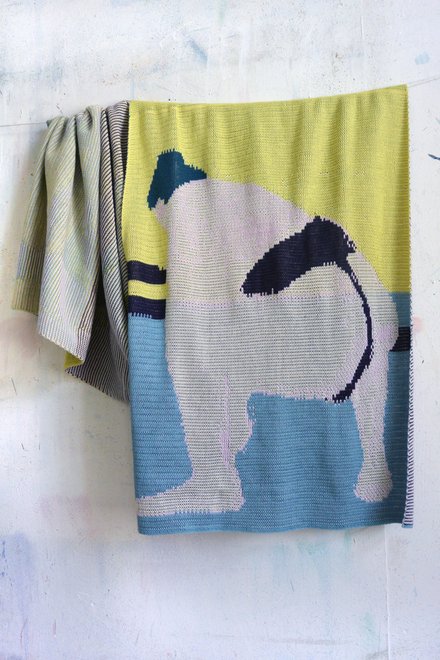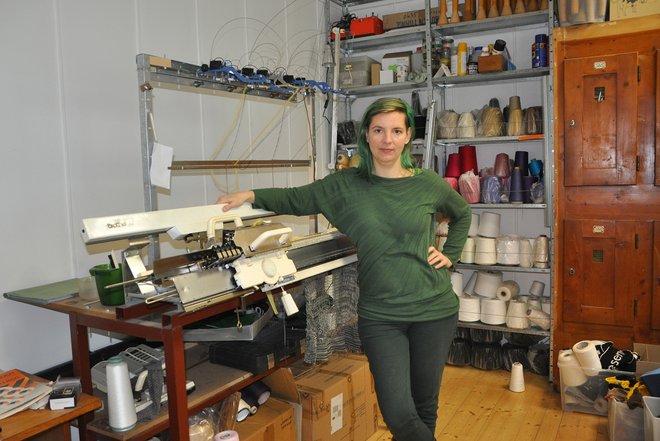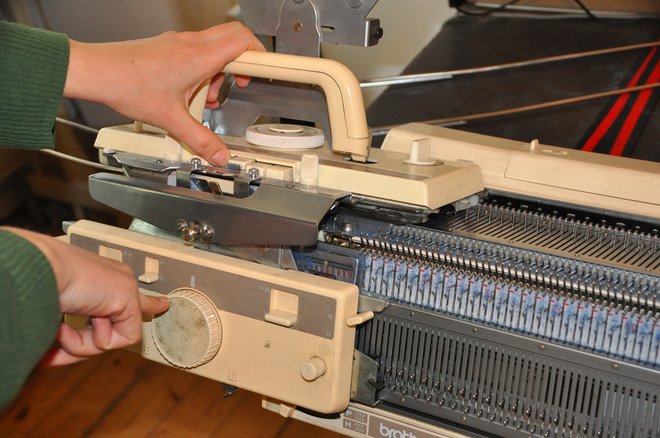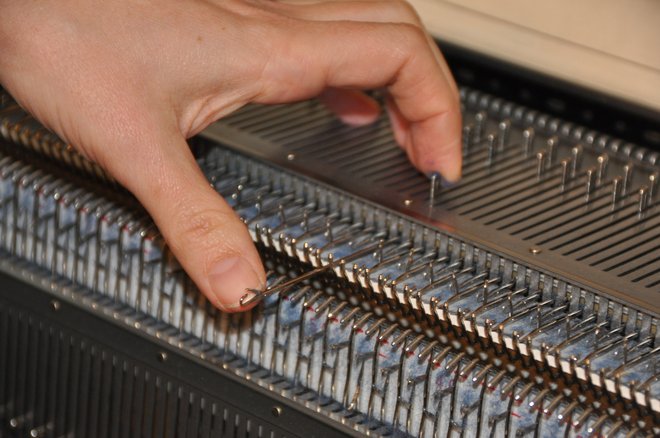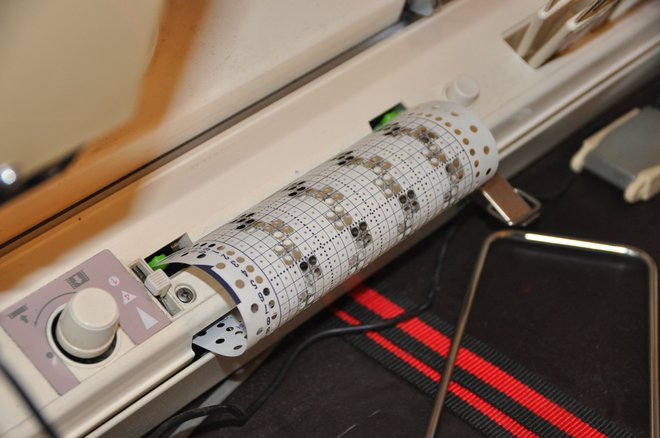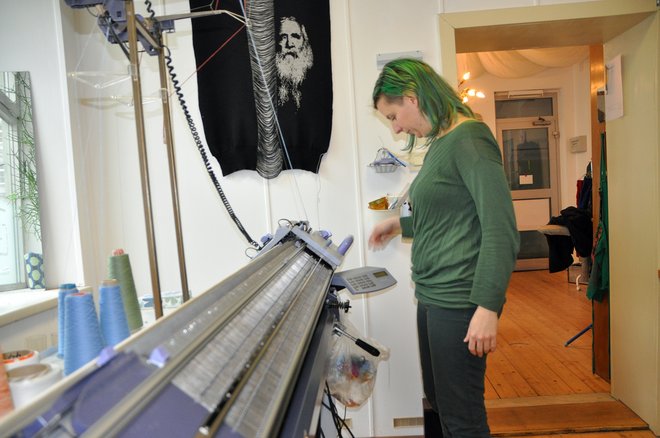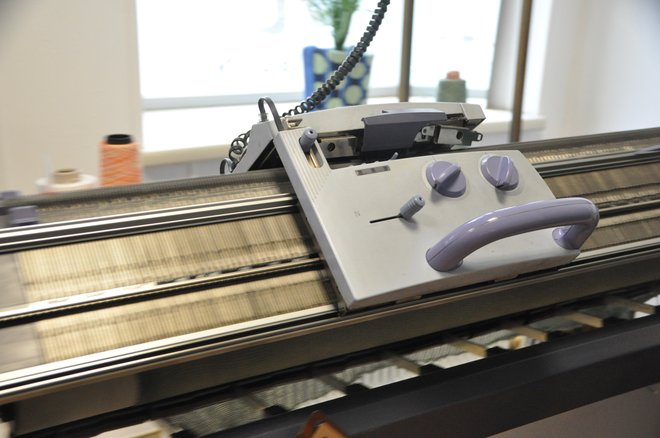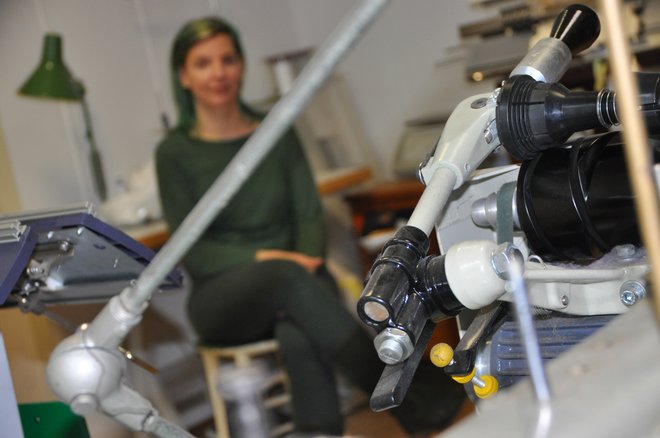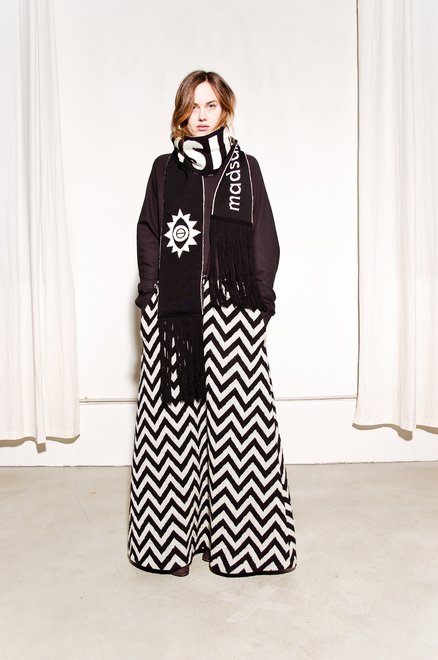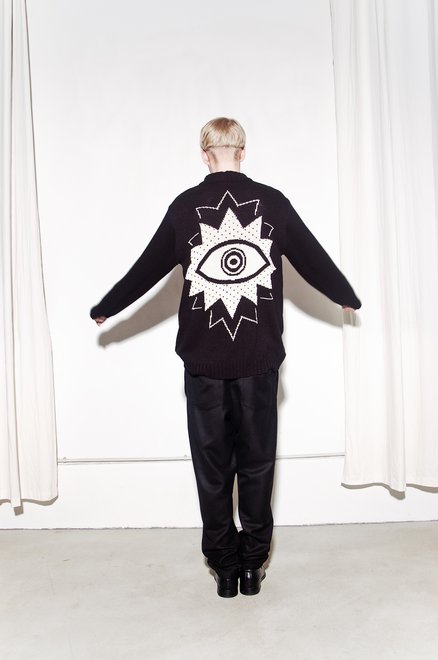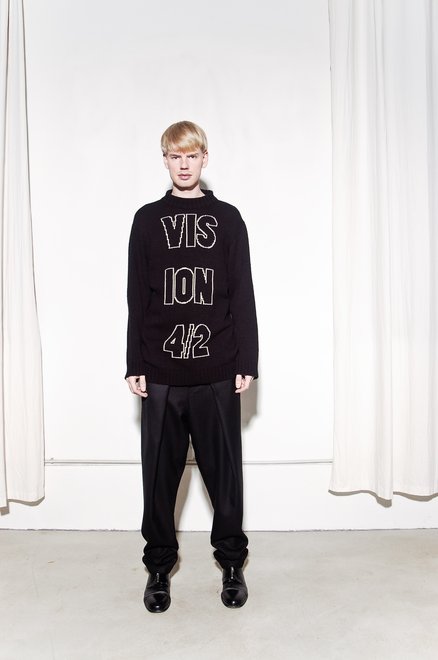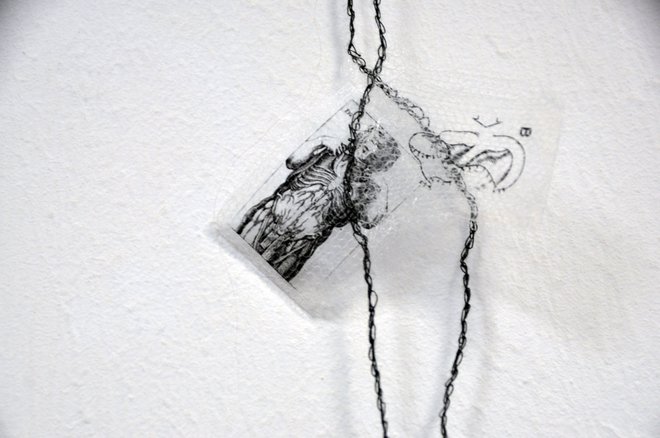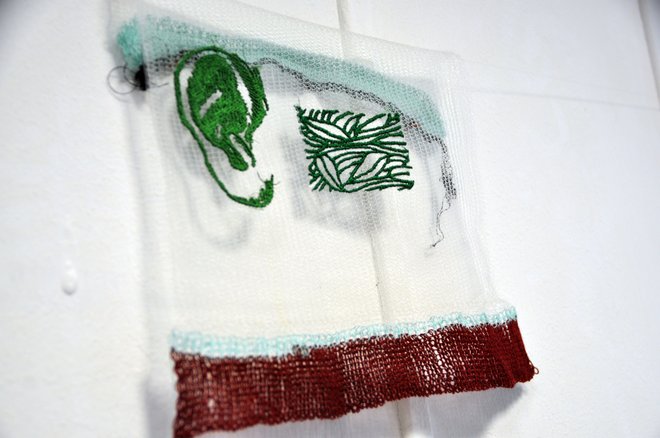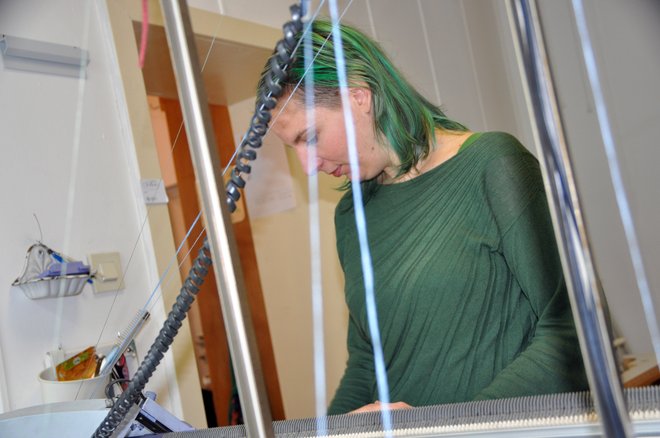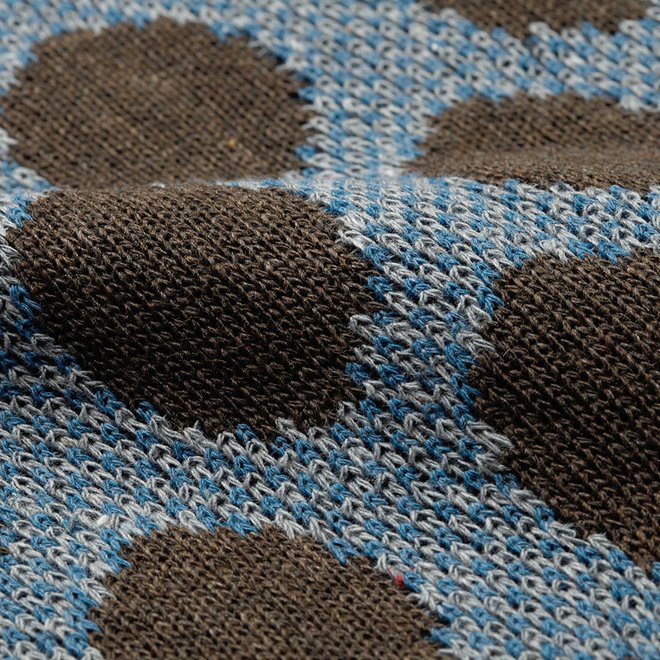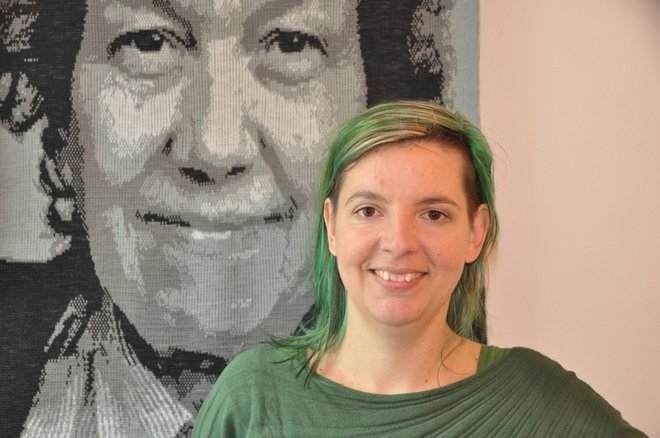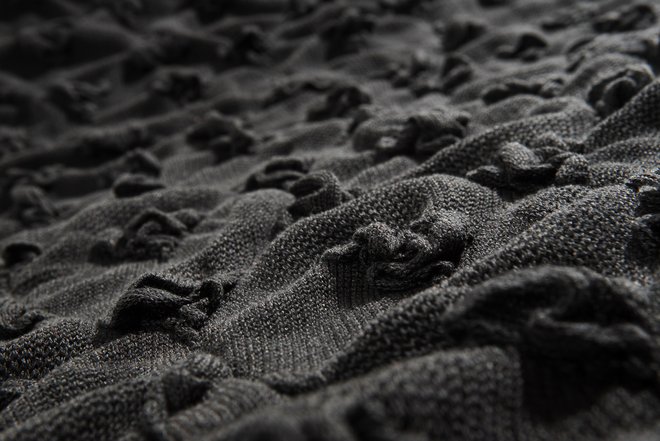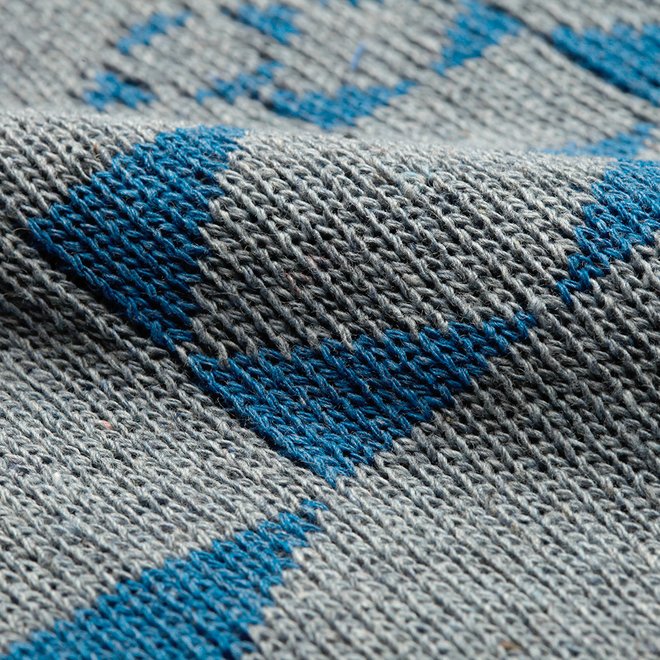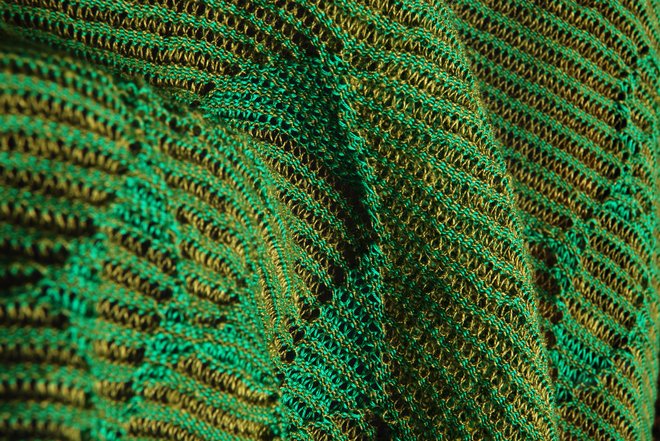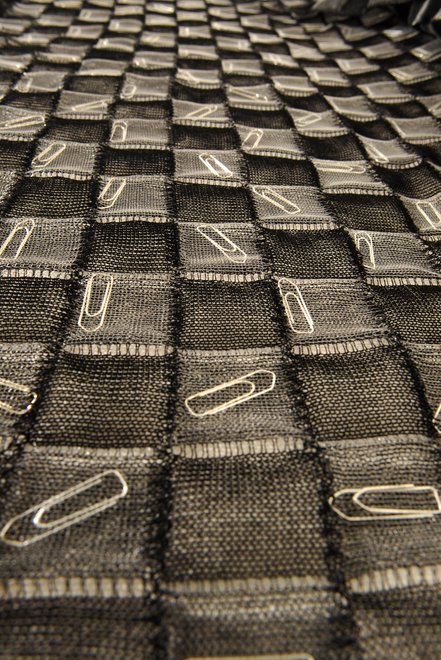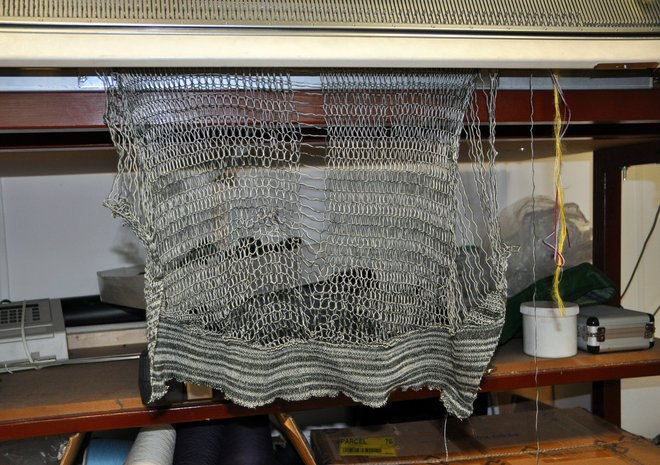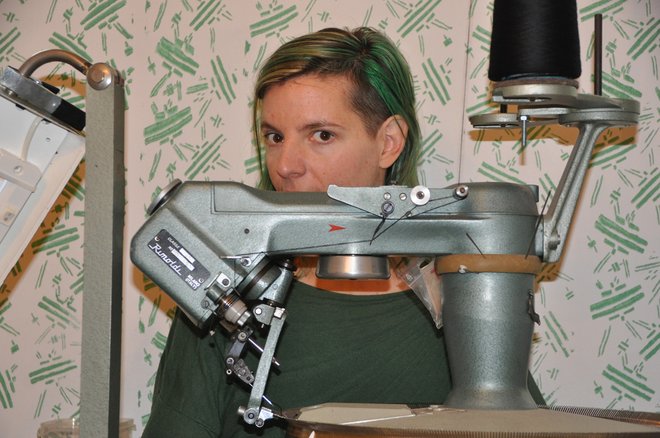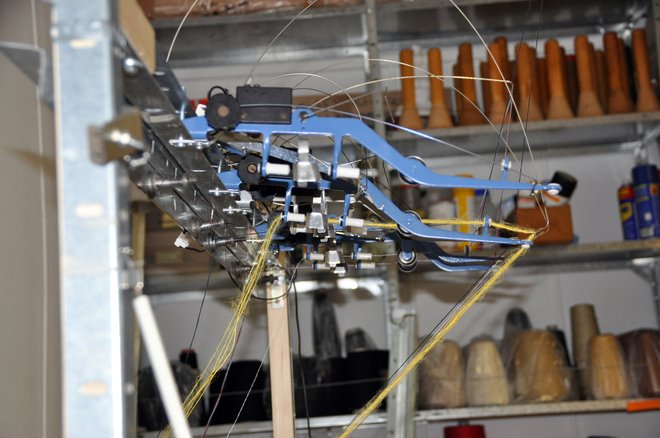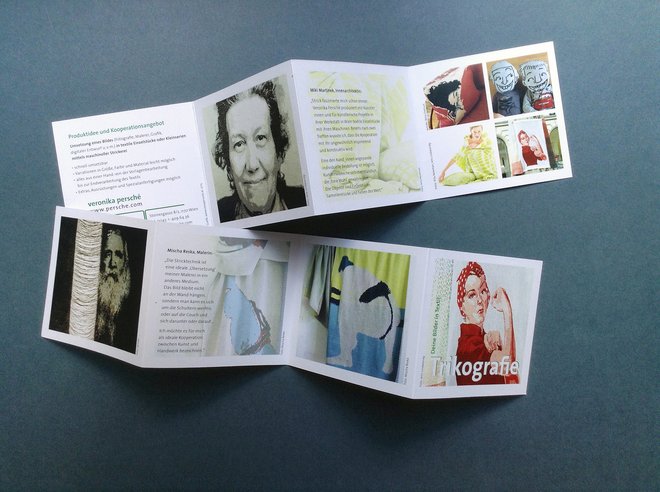Experimental Knitting Design
In her knitting workshop in the 17th district Veronika Persché produces textiles for clients from Austria and abroad. She is a luminary in her field, she collects knitting machines like others do buttons, and her pattern designs are “definitely not inspired by nature”. That she has clothed herself from head to toe in green since her childhood, well, that’s another story…
Lisa Peres: You have a passion for everything that has to do with knitting. Where does that come from? Didn’t you dress warmly enough as a child?
Veronika Persché: Quite the contrary, my mother used to knit a lot. She was a needlework teacher in disguise, so to say, but not as strict as the most. (laughs) She passed on the starters about knitting to me and my siblings in a very relaxed manner. She even understood this handcraft as a form of artistic expression. And I’ve hung onto this approach!
“Nothing is unknittable!”
What is your official professional title? Knitting expert? Knitter?
That’s not so easy to answer. I am a trained textile designer and educated gold and pearl embroider assistant. I manufacture off-the-roll knitted fabrics, knitted prototypes, and custom products. I took me a long time before I could call what I am doing art. I am a melange of designer, craftsperson, and artist. Technique plays a major role for me – the knitting machines have to be maintained, controlled, and technically mastered. What I do can best be compared with computer art.
You even knit cartoons!
You could say it like that. For Kris Hofmann, a London-based Austrian who produces analog stop motion films with a splendid handcraft quality, I had to knit a house in an animation about thermal insulation. That was really challenging! Everything had to fit to the millimeter for a model just 50 by 60 centimeters.
Did you ever have to reject a commission because it was technically impossible?
No, nothing is unknittable! But there are things that do not work with my equipment. From the technical perspective, my specialty is knitted images – I can translate every image, photo, or text into knitting.
How do you work? When you design what is your orientation point? Which forms inspire you?
Not really plants or nature. (We both laugh, perhaps because her “greenness” would suggest a contrary assumption). There are often monotonous moments when working on the knitting machine, that’s when I have ideas, simply while watching the machine and the stitches. Or I look on the street, see what people are wearing, how they look, what kind of façades the houses have. Such things!
“If I had all the money in the world I would buy an industrial machine!”
I heard that you even knit for the Salzburg Festival and famous artists?
Yes, at the moment I am knitting bulk fabric for the Westside Story costumes, and I also produce for Theater an der Wien quite often. For instance, when a piece takes place in the 1940s and the main actress should wear a pullover from the period, then I can deliver. My most prominent customer was quite definitely the Austrian artist Erwin Wurm. Time and again he dealt with knitted pullovers and with their elasticity and plasticity. I made a number of commissioned works for him. Also the pullover for the oversized potato-like bulbs were very funny. I also transform Mischa Reska’s paintings into 1:1 knitted images. And I knit scarves from her sumo wrestler motifs.
You don’t only knit, you are practically also a collector of knitting machines! That’s a rather eccentric hobby…
(Veronika Persché’s eyes light up with enthusiasm) My first knitting machine was a KR850 from the company Brother; it is already electronically controlled. In the 1960s to 90s such devices were conceived as household machines for small enterprises or for a housewife talented in handcrafts. And then I have a coarse knitter, also from the same company. It works totally mechanically and quite old-fashioned with punch cards. The machine is “back to the roots”. I have to punch laminated cards with such a pincer tool. The third, a CK35 – also from Brother – is a semi-industrial machine. That means that it is electronic and also has a motor attached to it. But I had the most fights, crises, and horror scenarios with this one. I cursed this machine, even though it didn’t really deserve it.
I see you have an almost loving relationship with your machines. Is there a favorite?
Yes, my favorite is the Passap E8000. True Swiss craftsmanship. It is so precise and sophisticated! Nothing comes loose or wobbles, everything interlocks smoothly – like a Swiss watch. It’s very elegant and space-saving. I got it in Portugal. The owner wanted to get rid of it because he needed the space. Back then I flew there myself and disassembled it with a friend, packed it up, and sent it on its voyage to Vienna.
If you had all the money in the world which machine would you buy?
Naturally an industrial machine. There are two major manufacturers left in the world. That’s the company Stoll in Germany and the company Shima Seiki in Japan. They make the knitting machines that stand in the clothing factories. The latest models can play all the roles. For example, you can program it for a pullover, and it comes out completely finished. Virtually seamless. It is completely circular knitted. You can make sculptures with this thing!
“Funny enough, I never knit anything for myself. Is that psychosomatic?”
Who’s the boss – you or your machines? Can you repair all of your machines yourself?
I’ve been doing this for 15 years. Programming has always been the easier part; I’m always the boss when it comes to that. But the mechanical aspect was a big problem for me in the beginning. The machine controlled me in that case, and I was often distraught by all of the things that can go wrong. But in the meanwhile it has become routine. I also notice that in the courses that I teach. We’ve come to terms, the machines and I, and there are practically no more breakdowns – or rarely.
Is it difficult to purchase quality wool and yarn as a self-employed entrepreneur?
That’s an important topic. The textile industry has moved out of Europe. It’s quite hard to get the products here. The major yarn manufacturers only want to supply the big factories with large quantities, from 20 to 30 kilograms per quality and color. I require a total of about 100 kilograms per year. But there is a dealer in Bad Fischau where I buy my yarn. Sometimes – when you say you are a designer and have luck – you can also order smaller amounts from large companies. Incidentally, fairtrade is also very important to me and my clients.
You likely also have designers knocking at your door…
Several years ago I did a lot of things together with the Austrian fashion designer Ute Ploier, and also with Mischa Woeste from Berlin (the label Smeilinener) and Miki Martinek, she is an interior designer. Every now and then I produce fabrics for her, for cushioned furniture, blankets, and pillows. I was also represented with her in the Vienna Design Week. My favorite client at the moment is Mads Dinesen – a charming Dane with a fashion label in Berlin. I just designed a scarf for him for the brand new Vision 4.2 winter collection, and earlier also rather sophisticated pullovers.
Do you personally wear a lot of knitwear?
Yes, I don’t really like blouses so I wear more knitwear. Funny enough, I never knit anything for myself. Is that psychosomatic, perhaps? Maybe it is because I don’t get paid for it (laughs), then I cannot submit an invoice for it. Anyway, I am not all that fashion affine. I’m only marginally interested whether a textile drapes so or so from a body. I don’t really want to deal with that.
Are you a smart salesperson?
I think so. I don’t sell myself for less than I’m worth! That’s often common practice in the textile branch. I also just make things that are paid. Which is sometimes a bit difficult with commissions for art actions. In my opinion, artists should be paid properly for their exhibitions and performances.
Do think that the knitting handcraft could die out?
It could die out in Europe; in America it pretty much doesn’t exist anymore. The really big knitting factories are located in Asia. In Austria there are still a few small companies, who can just barely survive from it. When the older owners retire and it is not passed on to the next generation, then nothing comes after it. On the other hand, handcraft currently receives a lot of attention again with this ecological and fairtrade wave. I can also imagine – or better said I hope – that the production will return from Asia once again. One of these days someone will do a real calculation of the transportation costs, and the oil price will be so high – something’s got to break.
Is there another profession you can imagine doing?
I would love to learn many other handcrafts. A tiler, for example! (laughs) That would be fun, setting tiles! Sticking things to the floor and making patterns, totally cool. I laid a lot of tiles myself in my own flat, in fact. I probably didn’t do such things enough as a youngster. I never had toy blocks or Lego, that’s probably why I have such fun with these constructive things!
Your knitting workshop is in the 17th district. Can you recommend what you find cool in your neighborhood?
Yppenplatz is just around the corner – it doesn’t need another recommendation cause it is already so full of bobos. But the neighborhood is quite OK. Here on Steinergasse there are 12 studios in the building with artists, designers, and architects. I totally recommend is “Biofisch”, a company here in the courtyard. They have a nice little tavern and breed biological carps, trout, and chars. They’re served fresh from the farm and filleted here.
Thanks for the talk!
The Vienna native Veronika Persché (*1976) designs and produces fabrics for Austrian and international creatives in her knitting workshop in Vienna. The clients of the knitting expert come from the fields of fashion, interior and costume design, applied and fine arts. Since 2001 the textile artist has been developing one-off knitted products and small series, which have been presented at national and international exhibitions. Veronika Persché is a trained gold and pearl embroider assistant and trained textile designer. Since 2004 she has held regular lectures and seminars on the handcraft of mechanical knitting, for example at Geneva University of Art and Design, the University of Arts and Industrial Design Linz, the Academy of Fine Arts Vienna, and the Textile Centre Haslach. She is a member of the ETN – European Textile Network.
Current Workshops:
Knitting Sessions , April 6 - 9 & June 1 - 4
Current Events:
Maker Faire, April 16 - 17, Facebook
Schneiderei-Markt, May 21 - 22



